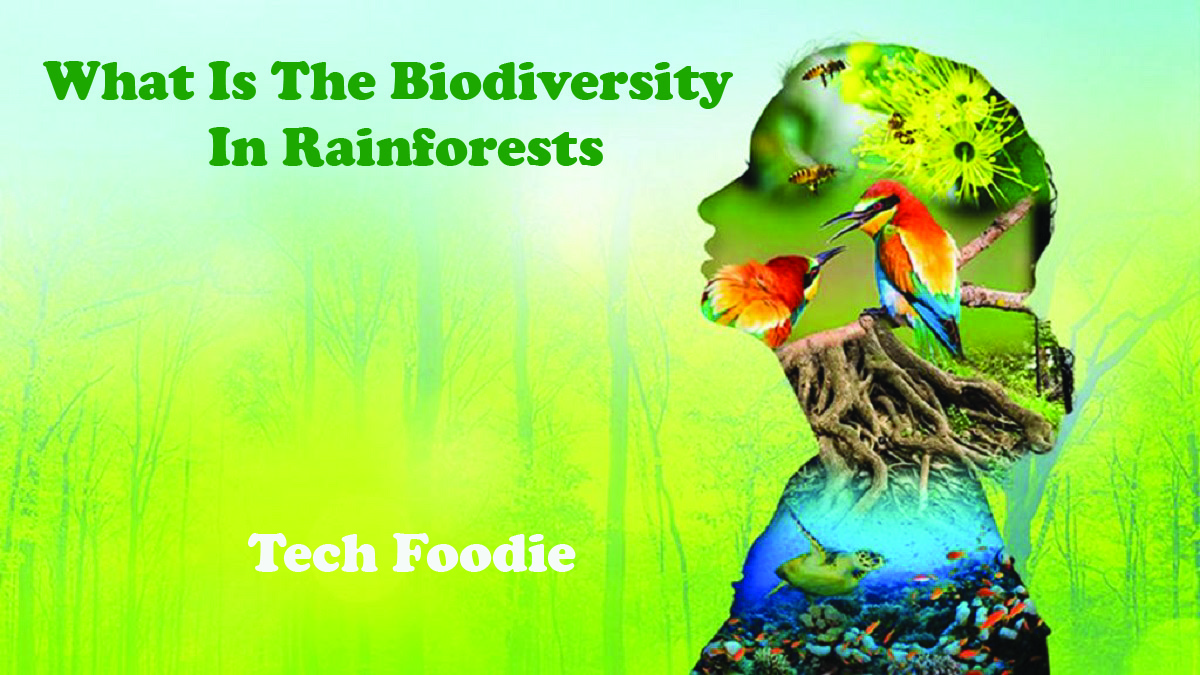What Is The Biodiversity In Rainforests – Tropical Rainforests
Rainforests are very diverse in terms of living species present in them. Although they cover less than 2 percent of Earth’s surface, rainforests are the habitat of an estimated 50% of all life on the planet’s land masses. The true extent of Biodiversity in rainforests remains a mystery. It is awe-inspiring that these remarkable ecosystems are believed to harbor an astonishing range of 3 to 50 million species, making them unrivaled champions of biodiversity on our planet. These estimates highlight the unparalleled richness and complexity of life within the rainforests, making them extraordinary and invaluable contributors to the global ecosystem. It is far higher on a per area basis than temperate, subtropical, and boreal ecosystems.
In this article, we will explore the climate and other factors of Biodiversity in rainforests.
What Is Biodiversity?

Biodiversity is the short form of biological diversity, and it describes different types of life you will find in one area. It includes the variety of plants, animals, fungi, and microorganisms, such as bacteria that make up our natural world. Each organism and species work together in an ecosystem and maintain a balance to support life.
The diversity of life, or biodiversity, plays a vital role in sustaining everything we need to survive in nature. It encompasses a wide range of essential aspects, such as providing us with food, ensuring the availability of clean water, offering medicinal resources, and even contributing to the creation of shelter.
When it comes to food, biodiversity is the foundation of agricultural systems. It encompasses the variety of crops, livestock, and marine life we rely on for nourishment. A diverse range of plant and animal species contributes to the resilience and productivity of our food systems, ensuring a stable and abundant food supply.
Clean water is another crucial resource that is supported by biodiversity. Healthy ecosystems, such as wetlands and forests, act as natural filters, purifying water and maintaining its quality. The presence of diverse plant and animal species helps regulate water flow, prevent erosion, and filter pollutants, thus ensuring the availability of clean and freshwater sources.
Biodiversity is also a treasure trove of medicinal resources. Many plants, animals, and microorganisms found in nature harbor compounds used for centuries in traditional medicine. They provide natural remedies and potential cures for various diseases and health conditions. Preserving biodiversity is essential for the continued exploration and discovery of new medicinal breakthroughs.
An Overview Of Biodiversity In Rainforests
In temperate forests, you will usually find a small number of tree species, perhaps just six or so, that comprise most of the forest’s tree population. On the other hand, tropical rainforests are full of an incredible diversity of life. In fact, in just one hectare of a tropical rainforest (equivalent to about 2.5 acres), you can find over 480 different species of trees. That’s quite surprising, isn’t it?
But it does not stop there. Even on a smaller scale, the biodiversity of rainforests is mind-boggling. Take a single bush in the Amazon, for example. It can host more species of ants than you would find throughout the entire landmass of the British Isles. This level of diversity in rainforests is not a random occurrence. The outcome of a series of unique circumstances has shaped these ecosystems over time.
The intricate web of life in rainforests, from the multitude of tree species to the incredible array of insects and other creatures, is a testament to the richness and complexity of these environments. It is truly fascinating how nature has created such extraordinary diversity within the tropical rainforests, making them a treasure trove of life and a vital part of our planet’s natural heritage.
Climate In Rainforests With Respect To Biodiversity
Let’s look at the rainforests’ climate to understand why it has very high biodiversity compared to other forests.
1. Solar energy/Climate
The climate of rainforests is hot and humid, which plays an important role in the variety of species. It is a general rule that ecosystem productivity and diversity increase with the amount of available solar energy in the system. The plants capture sunlight through photosynthesis, convert it into simple sugars and transfer it throughout the forest energy system when other organisms eat the fruits and leaves of these plants.
The number of carbon plants fixed is a key indicator of ecosystem net primary production. When it comes to this measure, tropical rainforests stand out as champions. They exhibit the highest average net primary production among terrestrial ecosystems, meaning a single acre of rainforest can store more carbon than any other vegetation type. This ability to capture and retain carbon is a significant contribution of rainforests to our planet’s carbon cycle.
One crucial factor that contributes to the remarkable diversity of rainforests is the presence of abundant water. The humid climate in these regions is vital for supporting a rich variety of life. The ample water supply nourishes the countless plant and animal species that thrive in these ecosystems, making rainforests hubs of biodiversity.
2. Stability - Biodiversity In Rainforests
The stable environment of tropical rainforests plays an important role in promoting diversity because it allows plants and animals to interact with each other without protecting themselves from cold or frost. In addition, because the sun shines here all year long, allowing plants to manufacture food through photosynthesis, so there is no food shortage in the ecosystem. The abundant food in the form of plants is passed up to the herbivores that eat leaves, fruits, and seeds and from them to the carnivores that eat herbivores. For millions of years, rainforest species have undergone extensive adaptations to exploit abundant food resources and fully capitalize on diverse niches.
Many visitors to the rainforest are often taken aback by their initial impressions, as they mistakenly equate the term “diversity” with “abundance.” Their expectations lead them to envision encounters with numerous jaguars, scores of iguanas lounging on lodge patios, and majestic toucans ready to greet them with breakfast. However, the reality is quite different. Unlike the sweeping herds of wildebeest and zebra found on the African savanna, the rainforest does not boast such dramatic spectacles. Nor does it present an explosion of vibrant flowers or an abundance of colorful birds. Instead, life in the rainforest unfolds with remarkable subtlety, revealing its hidden wonders more nuanced.
Although the number of species is abundant in the rainforest, it does not mean one given species is plentiful. Some species have millions of individuals, while others have a population of only a handful of individuals.
3. Canopy Structure Of Rainforest And Biodiversity
The intricate canopy system in tropical rainforests enhances biodiversity by offering many new opportunities for various life forms. It creates unique niches that provide fresh sources of food, safe shelters, hidden retreats, and spaces for interactions between different species. Surprisingly, a staggering 70-90 percent of rainforest life thrives within the canopy. One remarkable example of how the canopy fosters diversity is through the presence of epiphytes. These fascinating plants form miniature ecosystems of their own. Take, for instance, the tank bromeliads found in the forests of the New World. These plants possess upturned leaves that create catchments capable of holding over eight liters of water. Within these pools, frog tadpoles and insect larvae specially adapted to this unique habitat thrive, while millions of other canopy-dwelling creatures benefit from the water supply. While science has identified around 28,000 species of epiphytes, countless more likely remain undiscovered and unexplored.
Beyond epiphytes, other plant species like lianas and creepers provide ground-dwelling animals with pathways to access the resources present in the canopy. Many familiar ground-dwelling animals from temperate regions, such as porcupines, kangaroos, anteaters, earthworms, and crabs, have adapted to tropical environments and made their homes in the canopy. This migration to higher levels within the rainforest contributes to the richness and complexity of life in these extraordinary ecosystems.
4. Soil Of Biodiversity In Rainforests
The composition and fertility of rainforest soils are essential factors in shaping the diversity of the forest ecosystem. While around 70 percent of tropical rainforests thrive on poor acidic soils, their fertility is sustained through natural processes like nutrient recycling. However, certain regions have exceptionally impoverished soils, restricting the growth of only a limited range of tree species. Despite this limitation, these forests still showcase more diversity than temperate forests. An intriguing example is the “white-sand” or “blackwater” forests that grow on rocky, sandy soils. Trees in these environments adapt by clinging to rocks and the roots of other trees. Their leaves contain tannins, which seep into nearby rivers, giving them a distinct “blackwater” appearance. Bitter tannins restrict insect populations, impacting food availability for larger animals that rely on insects as a primary food source. These self-sustaining “blackwater” forests continue to shape their surroundings by further limiting the growth of other tree species on nutrient-deficient soils.
In contrast, forests with saturated soils, such as the igapò or “swamp forest,” tend to have lower tree diversity, primarily dominated by a few adaptable species like Cecropia and palms. Consequently, the abundance of animals in these areas depends largely on their reliance on these dominant tree species’ fruits, leaves, and seeds.
Forests with high biodiversity often thrive on nutrient-rich soils, sometimes resulting from volcanic activity that provides good drainage. These forests are often protected from major disturbances like strong winds and regular flooding, allowing diverse plant and animal life to flourish.
The intricate relationship between rainforest ecosystems and soil characteristics underscores the complex interplay of factors contributing to the extraordinary diversity observed in these captivating environments.
Conclusion
In conclusion of Biodiversity in rainforests, rainforests are unparalleled champions of biodiversity, housing an astonishing range of species and contributing to the global ecosystem in invaluable ways. The remarkable diversity in these ecosystems results from a combination of factors, including the hot and humid climate, abundant solar energy, stable environment, and intricate canopy structure. The rainforest’s climate provides favorable conditions for a rich variety of life to thrive, while the canopy offers unique niches and opportunities for different species to interact. Additionally, the composition and fertility of rainforest soils play a role in shaping the diversity of these ecosystems. Despite variations in soil types, rainforests exhibit higher biodiversity than other forest types. Understanding and preserving the intricate relationship between rainforest ecosystems and their diverse inhabitants is crucial for the continued exploration of new medicinal resources, sustaining agricultural systems, and ensuring a stable and abundant food supply. Recognizing the importance of rainforests and taking measures to protect and conserve them is essential for preserving the Earth’s natural heritage and maintaining the delicate balance of life on our planet.
Read More: A COMPREHENSIVE GUIDE TO PURPLE CORN



